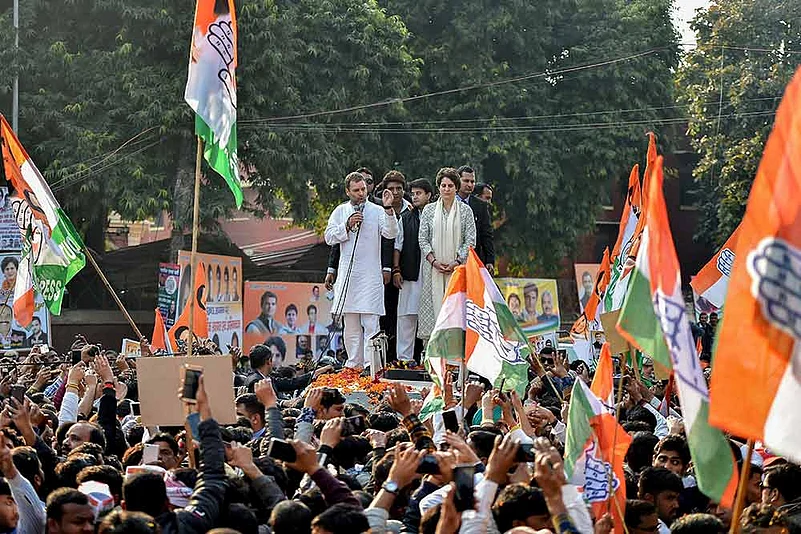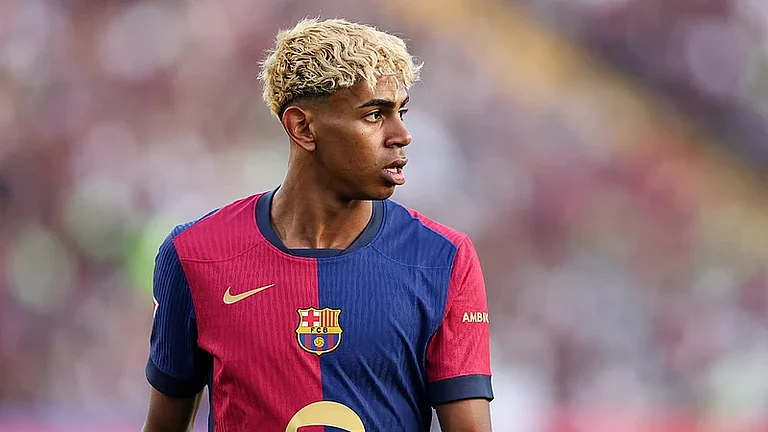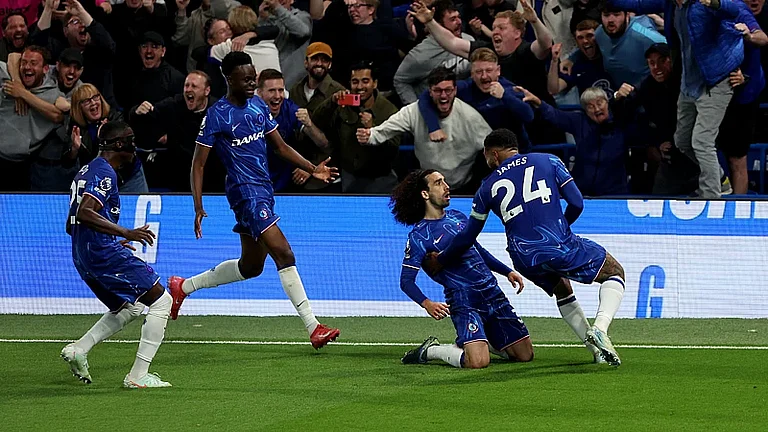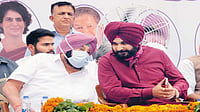Within a couple of days, the prime minister had to take to outer space to change the narrative. Soon enough, the usual choristers and critics were out fighting online. “Only Narendra Modi could have done it,” said one side. “Surgical strike on jehadi aliens,” said a Twitter wit. What compelled him, though, to strain at the leashes of the Model Code of Conduct and make a statement of India’s space capabilities? Something that was happening back in the space of terrestrial reality. His chief rival, the Congress, has been behaving a bit like a shooting star in recent times—one minute it’s on a brilliant surge, the next minute you can’t see the damn thing. But early this week, it had shaken off the supine defeatism it sometimes exhibits and come out with a policy promise that got everyone talking.
The jury is still out on whether Congress president Rahul Gandhi’s poll promise to 20 per cent of India’s poorest of a minimum income guarantee of Rs 72,000 per annum is a fiscally prudent idea. Or, in the immediate term, whether it can be a game-changer in the Lok Sabha polls. But the question was evidently urgent enough for the Modi dispensation to respond with something dramatic—to up the game from aerial dogfights to space missiles. For, after over a month of being in an awkward reactive mode since Pulwama-Balakot, it seemed as if the Congress had succeeded in steering the Lok Sabha poll narrative away from the BJP’s chest-thumping triumphalism.
As a policy promise, it was a deft hand that the Congress played. The feasibility of NYAY—Nyuntam Aay Yojana—is secondary at the moment. What matters is the extent to which it can strike an emotive chord. And steer the conversation back to unemployment, agrarian distress and poverty—the Achilles heel of Prime Minister Narendra Modi’s government. In short, to take the game away from where the BJP plays strong: election rhetoric dominated by a cocktail of jingoistic nationalism and Hindutva pride. Judging from the BJP’s own response, it’s not underestimating NYAY.
But will it suffice to make up for the ground the Congress has lost in common perception? The Balakot air strikes didn’t just create a talking point: intangibles like the ‘public mood’ have a material effect on political affairs. The air had suddenly seemed favourable for the Congress after its spectacular victories in the assembly polls last winter. There was a new spring in its step—even a touch of smugness in its social media voices, a sense of having ‘arrived’. A ‘grand’ Opposition alliance seemed at hand. After Pulwama-Balakot, the script bottomed out. Buoyancy was replaced by an air of desperation, then resignation. Alliance talks started foundering all over the place. All of a sudden, 2019 seemed a no-contest.

Rahul and Priyanka at a roadshow in Lucknow.
That’s where this new edition of Garibi Hatao comes in. In Rahul’s dogged struggle to shake off the infantile image of him spun by his critics and get taken seriously as prime ministerial material, NYAY may be the most ambitious step yet, in both form and content. Linguistic felicity is one trait rarely attributed to the Gandhi scions. But NYAY, the acronym, was coined by Priyanka Gandhi Vadra. (Twitter wits were also offering MIG-19!) At the more substantive level, Rahul says the fine print—the nuts and bolts of how they intend to raise the money required to deliver a guaranteed minimum income of Rs 12,000 per month to five crore households—will be spelt out in the party’s manifesto. Also, the logistics of identifying the beneficiaries.
Nor is it a hastily sketched scheme—the blueprint has been in the works for over eight months, say party sources. Rahul was keen that the manifesto committee, headed by former FM P. Chidambaram, prepares a realistic scheme etching out a ‘new paradigm’ in social and financial inclusion. His brief was simple: it should be easy to execute and easier to explain to the masses. A source privy to the consultation says Rahul personally called on several noted economists, including JNU’s Prof Arun Kumar, to understand different models of universal basic income from across the globe. Ideas were also sought from Dr Amartya Sen, though it was not clear whether Rahul had personally met the Nobel laureate or sent an emissary. Dr Manmohan Singh too was in the loop.
The only real surprise was the timing, and that speaks of a new savvy about the nature of the game. Rahul’s decision to announce the scheme on March 25, sources say, was unscripted. It went like this. It was that very day that Chidambaram brought the draft of the party manifesto, with details of NYAY, to the CWC. After a thorough discussion, Rahul said he wanted to go public on NYAY immediately instead of waiting for the formal launch of the manifesto, scheduled for early April. He obviously wanted it to inflect the public mood, and allow enough time for the news to filter down everywhere before the first phase of polling on April 11.
Its subliminal messaging is key. “For voters in the 18-40 age bracket angry at Modi for taking away their jobs or wiping out their savings post-demonetisation, a vote for NYAY is a referendum against the BJP’s policies,” says Congress MP P.L. Punia. “For those who remember the social inclusion programs of Indira and Rajiv Gandhi, NYAY is an extension of what the Congress has traditionally stood for.” For the economically distressed, it promises a return to the maternalistic care of ‘big government’, a tempting idea in times when the economic weather mostly suits big business.
Rahul’s words were well-chosen in that respect. He called the scheme a “final assault on poverty”, and framed it within a logical formula—“If Modi can give money to India’s richest, the Congress can give money to the poorest people of this country.” Reluctant politician? Well, this is a changed Rahul, one who knows how to weaponise his words, one invested with a coherent politics and sense of timing. The spin Rahul gave to NYAY is logically congruent with his broadsides against Modi—the “suit-boot ki sarkar” and “chowkidar chor hai” taunts, the charge of “stealing Rs 30,000 crore from Indians to give to Anil Ambani”. Besides, of course, being strongly reminiscent of Indira Gandhi’s iconic 1971 poll slogan—Garibi Hatao.
No wonder the BJP and its IT cell shot back with the slogan—“chauthi peedhi, vahi naara, arey yeh hain poore nakara”—accusing the dynasty of falling back on a 48-year-old slogan. FM Arun Jaitley called it a “bluff”, saying Rs 72,000 is “less than 2/3rd” of existing direct benefits. But all the protestations only seemed to embolden the Congress. “They are nervous because they know people haven’t forgiven them for their Rs 15 lakh jumla. And the loan-waivers by our governments in MP, Chhattisgarh and Rajasthan days after being voted to power has assured people that we don’t make false promises,” former Union minister Kumari Selja told Outlook. Another senior Congress leader feels the average voter will only think of “Rs 72,000 coming into their accounts”, not “calculate how much they currently get under X,Y,Z schemes”.
The 2019 elections are obviously playing to an open script—the game is on till the last voter punches a button on May 19. But has the Congress done enough to take a standing leap from its disastrous score of 44, and the 19.52 per cent voteshare, of 2014? Has the Grand Old Party, all of 134 years of age, put on a new coat of paint appealing enough to voters used to Modi’s teflon? Even if December 2018 punctured Amit Shah’s barb of a ‘Congress-mukt’ India, the fact is that it’s absent or in serious attrition over large parts of India’s political map. Before this winter, over a dozen assembly polls had ended in ignominy for the Congress. Rahul’s helmsmanship seemed underwhelming—his simplistic oratory and propensity for gaffes embedded deeper the derisive appellation of ‘Pappu’ the BJP stuck on him.
But starting with the scare the party gave to the BJP in Gujarat, a transformation was visible. Veteran journalist Harish Khare says, “There’s no doubt Rahul has matured in politics. Many changes he has brought are for the better and were unthinkable during Sonia Gandhi’s time.” For instance, the way he allowed “the three musketeers of Gujarat—Alpesh Thakor, Hardik Patel and Jignesh Mewani—to almost run the show in the assembly polls”. There are other ‘unthinkable changes’ too, not necessarily kosher in terms of political ethics but a step up in strategic nous. Take the way Rahul shed the Congress’s traditional hard secularism to experiment with soft Hindutva—asserting his Shiva-bhakt, janeudhari identity, allowing a rightward lurch on Sabarimala, opting for tactical silence on mob lynchings of Muslims.

People in Amritsar watch PM Modi’s March 27 address to the nation.
At a personal level, criticism about his lack of concentration—renegade Himanta Biswa Sarma’s “dog and biscuit” barb being the harshest—has ebbed. Rahul now regularly interacts with (and listens attentively to) academics and professionals. There’s also a new spiffiness to the party’s social media outreach. The party manifesto, sources say, reflects ideas that came up in this interpersonal space, as also crowd-sourced ones. At the organisational level, Rahul has been working to break the status quoism of the Sonia days. The change “is slower than expected” only because “the party’s electoral space has diminished and alienating veterans would force them to join the BJP or others”, says a senior Congressman. By not rushing the enthronement of young faces like Sachin Pilot, he has avoided repeating his father’s mistakes of the mid-’80s. This was no ‘Pappu’—as he told students at Berkeley in 2017, that was only an “image created by people the BJP paid to malign him day and night”.
The challenges before him have, however, not stopped piling up. No prime ministerial aspirant can afford to ignore Uttar Pradesh, the one state that boasts the maximum native-born PMs, and here the picture stays muddled. The qualified entry of Priyanka, and her decision to stick to campaigning (that too mostly in eastern UP), was a bit like forfeiting what the party has often called its brahmastra. Nor has she created much of a groundswell on the ground, say worried partymen. As for Rahul, at a more general level, he doesn’t command the respect Sonia does from other Opposition leaders. They see him as their junior in politics and, more importantly, as someone who stands in their way of going for prime ministership.
This reflects in the party’s alliance woes. Take the on-again-off-again talks with AAP, or the royal snub the Congress got from the SP-BSP in Uttar Pradesh. When the Left backed out in Bengal, it was more of a mood-spoiler than something with a huge numerical consequence. That came in Andhra Pradesh, where CM N. Chandrababu Naidu—the key spirit of the pan-India anti-Modi alliance plan—called off the TDP’s pre-poll pact with the GOP.
So critics have enough to pick on. “The Congress is like a blind bull in the cropping field,” says former Rajya Sabha MP from Telangana, Rapolu Ananda Bhaskar, who quit the Congress last week. “It’s making itself irrelevant in states that were strongholds just five years ago. There’s utter confusion and poll sops like NYAY won’t compensate for the lack of an organisation on the ground.” Aligning with the TDP for the Telangana assembly polls was “suicidal”, he says, adding that “allowing himself to be manipulated by Naidu” was a sign of Rahul’s political immaturity. “Why did he ally with the TDP in Telangana, where Naidu is hated because of his opposition to the statehood movement? Naidu has conveniently snapped ties now,” he points out.
Congress media cell chief Randeep Singh Surjewala is a trifle defensive on the point, but says the “impression that we have failed to keep our traditional alliances is wholly incorrect.” He cites the NCP in Maharashtra, RJD in Bihar, DMK in Tamil Nadu, JD(S) in Karnataka, the Congress-led UDF in Kerala, NC in Kashmir, and the latest—the four-party ‘grand alliance’ with JMM et al in Jharkhand.
Can the excitement and hype over NYAY force a rethink among other Opposition parties? Armed with this potential vote-catcher, Rahul is likely to shed his repetitive diatribe on Rafale. “That had stopped getting any traction with the masses long back…. With NYAY, Rahul can talk about unemployment and poverty with greater force and link it to Modi’s crony capitalism. Rafale won’t go away, but will become more tangential,” says a member of the Congress’s publicity panel.
It’s a pan-India policy blueprint, but the Congress is particularly interested in taking the NYAY message to the rural and semi-rural areas of the north. “These are the regions where, despite rising unemployment and agrarian distress, people were getting swayed by Hindutva. Unlike southern states, where we have strong alliances, here the contest is largely bipolar between us and the BJP,” says a party source. Of course, it’s never too late to have a Mani Shankar Aiyar or, current favorite Sam Pitroda, throw a full toss in the slog overs and give the game away. But the battle for Raisina Hill has become more exciting.


























